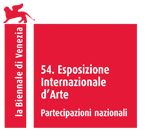Pavilion of Armenia
Pavilion of Armenia at the 54th International Art Exhibition – La Biennale di Venezia
Venue: Palazzo Zenobio, Former Collegio Armeno Moorat Raphael, Dorsoduro2597
Manuals: Subjects of a New Universality
The ongoing cultural and political debates in Armenia bring forth a fundamental dilemma. On the one hand, it is acknowledged that integration into the processes of globalization is a necessary condition for any meaningful modernization. On the other hand, this integration must not alter ‘our own identity'. This dilemma amounts to the following principle: to be with others, without becoming other; to remain the same while being modernized.
This tension between the universal and the particular also affects the contemporary art discourse in Armenia. Dealing with the tension the artists neither are getting ‘trapped' in it, nor gravitate towards its poles. Instead, the artists ‘sublate' this dichotomy without, however, detaching themselves completely from it. This act of sublation is materialized in a unique artistic format, a manual. Manual combines artists' singular efforts and their individual experiences with collective knowledge and universal models of human thought.
Any manual is a result of a singular effort to overcome a deadlock that implicitly suggests the way of achieving its goal as a general model. Thus, a singular effort motivated by an urgent need proposes itself as a subject of new universality. The specificity of this subject is that it includes in itself its own lack, i.e. the need that brought it into existence.
The artists involved in this project take the social, economic, and political turmoil of the post-Soviet Armenia as the platform for their artistic work. But by virtue of their belief in universality they model the singular efforts of dealing with these specific issues in a way that turns them into the possibility of universal emancipation.
Artists
Mher Azatyan is an artist-collector whose installations are comprised of the collected images and texts. At the basis of this often sudden and unexpected encounter between photography and text lies material scarcity. Going through the pains and losses, Azatyan still looks for the possibilities of living and creating. And he finds these possibilities in the most insignificant details: in micro constituents of mundane life and the most innocent and often amusing setups.
Grigor Khachatryan is one of those first artists in Armenia who shifted in 1970s towards conceptual art practices (performance, text and photography). The theme of power is central for his artistic oeuvre. Materials for Khachatryan's artistic production are his own persona, his body and his name. Implicit and explicit interventions in the printed and electronic media are essential for Khachatryan's artistic strategies.
Astghik Melkonyan's works articulate their own economic foundations. As such, they overcome the romantic division between “to work” and “to create” which is a major characteristic of the cultural scene of post-Soviet Armenia. Melkonyan elaborates specific formats, manuals, which address the economic dynamics of artistic work intertwined with larger techniques of social survival.
The Curatorial Team: Brief Bios
Ruben Arevshatyan is artist, art and cultural critic and free-lance curator. He teaches History of Art at the Department of Fine Arts at the Armenian Open University. He is the coauthor and co-curator of The Sweet 60s international research project, as well as the member of editorial board of the RED THREAD e-journal.
Vardan Azatyan is art historian, critic and curator. He is Assistant Professor in Art History at Yerevan State Academy of Fine Arts. As a Visiting Professor, Azatyan lectured at Columbia University in the City of New York, and the Dutch Art Institute. He is the cofounder and the vice-president of the AICA-Armenia.
Nazareth Karoyan is art critic, free-lance curator and president of AICA-Armenia. He is among the initiators of the international Summer Seminars for Art Curators. Karoyan is also the initiator and director of the two-year Program for Critical and Curatorial Studies in Yerevan.
Commissioner, Organization and Coordination
Pavilion of Armenia at the 54th International Art Exhibition – La Biennale di Venezia is being organized by the New Cultural Policy Foundation with the support of the Ministry of Culture of the Republic of Armenia and the National Assembly of the Republic of Armenia.
Viktor Mnatsakanyan is the president of New Cultural Policy Foundation and the Commissioner of the Pavilion of Armenia at the 54th International Art Exhibition – La Biennale di Venezia.
Armine Antikyan is the Chief Coordinator of the Pavilion of Armenia at the 54th International Art Exhibition – La Biennale di Venezia.
Vartan Karapetian is the advisor and coordinator in Venice of the Pavilion of Armenia at the 54th International Art Exhibition – La Biennale di Venezia
Website:
www.biennale.am
Viktor Mnatsakanyan
commissioner@biennale.am
Ruben Arevshatyan
Vardan Azatyan
Nazareth Karoyan
curators@biennale.am
Armine Antikyan
chiefcoordinator@biennale.am
communication@biennale.am
Contact information
info@biennale.am

